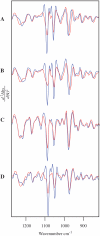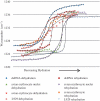Monitoring the reversible B to A-like transition of DNA in eukaryotic cells using Fourier transform infrared spectroscopy
- PMID: 21447564
- PMCID: PMC3141270
- DOI: 10.1093/nar/gkr175
Monitoring the reversible B to A-like transition of DNA in eukaryotic cells using Fourier transform infrared spectroscopy
Abstract
The ability to detect DNA conformation in eukaryotic cells is of paramount importance in understanding how some cells retain functionality in response to environmental stress. It is anticipated that the B to A transition might play a role in resistance to DNA damage such as heat, desiccation and toxic damage. To this end, conformational detail about the molecular structure of DNA has been derived primarily from in vitro experiments on extracted or synthetic DNA. Here, we report that a B- to A-like DNA conformational change can occur in the nuclei of intact cells in response to dehydration. This transition is reversible upon rehydration in air-dried cells. By systematically monitoring the dehydration and rehydration of single and double-stranded DNA, RNA, extracted nuclei and three types of eukaryotic cells including chicken erythrocytes, mammalian lymphocytes and cancerous rodent fibroblasts using Fourier transform infrared (FTIR) spectroscopy, we unequivocally assign the important DNA conformation marker bands within these cells. We also demonstrate that by applying FTIR spectroscopy to hydrated samples, the DNA bands become sharper and more intense. This is anticipated to provide a methodology enabling differentiation of cancerous from non-cancerous cells based on the increased DNA content inherent to dysplastic and neoplastic tissue.
Figures





Similar articles
-
Detection of an en masse and reversible B- to A-DNA conformational transition in prokaryotes in response to desiccation.J R Soc Interface. 2014 Aug 6;11(97):20140454. doi: 10.1098/rsif.2014.0454. J R Soc Interface. 2014. PMID: 24898023 Free PMC article.
-
The importance of hydration and DNA conformation in interpreting infrared spectra of cells and tissues.Chem Soc Rev. 2016 Apr 7;45(7):1980-98. doi: 10.1039/c5cs00511f. Chem Soc Rev. 2016. PMID: 26403652 Review.
-
The Application of ATR-FTIR Spectroscopy and the Reversible DNA Conformation as a Sensor to Test the Effectiveness of Platinum(II) Anticancer Drugs.Sensors (Basel). 2018 Dec 6;18(12):4297. doi: 10.3390/s18124297. Sensors (Basel). 2018. PMID: 30563229 Free PMC article.
-
Contribution of Ribonucleic Acid (RNA) to the Fourier Transform Infrared (FTIR) Spectrum of Eukaryotic Cells.Anal Chem. 2016 Dec 20;88(24):12090-12098. doi: 10.1021/acs.analchem.6b02744. Epub 2016 Nov 30. Anal Chem. 2016. PMID: 28193045
-
Understanding B-DNA to A-DNA transition in the right-handed DNA helix: Perspective from a local to global transition.Prog Biophys Mol Biol. 2017 Sep;128:63-73. doi: 10.1016/j.pbiomolbio.2017.05.009. Epub 2017 May 30. Prog Biophys Mol Biol. 2017. PMID: 28576665 Review.
Cited by
-
Optimization and validation of cryostat temperature conditions for trans-reflectance mode FTIR microspectroscopic imaging of biological tissues.MethodsX. 2017 Feb 2;4:118-127. doi: 10.1016/j.mex.2017.01.006. eCollection 2017. MethodsX. 2017. PMID: 28280690 Free PMC article.
-
The interaction of Ag2O nanoparticles with Escherichia coli: inhibition-sterilization process.Sci Rep. 2021 Jan 18;11(1):1703. doi: 10.1038/s41598-021-81305-5. Sci Rep. 2021. PMID: 33462370 Free PMC article.
-
Soil Particles and Phenanthrene Interact in Defining the Metabolic Profile of Pseudomonas putida G7: A Vibrational Spectroscopy Approach.Front Microbiol. 2018 Dec 4;9:2999. doi: 10.3389/fmicb.2018.02999. eCollection 2018. Front Microbiol. 2018. PMID: 30564224 Free PMC article.
-
Increased optical pathlength through aqueous media for the infrared microanalysis of live cells.Anal Bioanal Chem. 2018 Sep;410(23):5779-5789. doi: 10.1007/s00216-018-1188-2. Epub 2018 Jul 2. Anal Bioanal Chem. 2018. PMID: 29968104 Free PMC article.
-
Infrared Spectroscopy in Gynecological Oncology: A Comprehensive Review of Diagnostic Potentials and Challenges.Int J Mol Sci. 2024 May 30;25(11):5996. doi: 10.3390/ijms25115996. Int J Mol Sci. 2024. PMID: 38892184 Free PMC article. Review.
References
-
- Lever E, Sheer D. The role of nuclear organization in cancer. J. Pathol. 2010;220:114–125. - PubMed
-
- Dickerson RE. Definitions and nomenclature of nucleic acid structure parameters. J. Biomol. Struct. Dynam. 1989;6:627–634. - PubMed
-
- Hunter CA. Sequence-dependent DNA-structure – the role of base stacking interactions. J. Mol. Biol. 1993;230:1025–1054. - PubMed
-
- Florentiev VL, Ivanov VI. RNA polymerase - 2-step mechanism with overlapping steps. Nature. 1970;228:519–526. - PubMed
-
- Eom SH, Wang JM, Steitz TA. Structure of Taq polymerase with DNA at the polymerase active site. Nature. 1996;382:278–281. - PubMed
Publication types
MeSH terms
Substances
LinkOut - more resources
Full Text Sources
Other Literature Sources
Molecular Biology Databases

